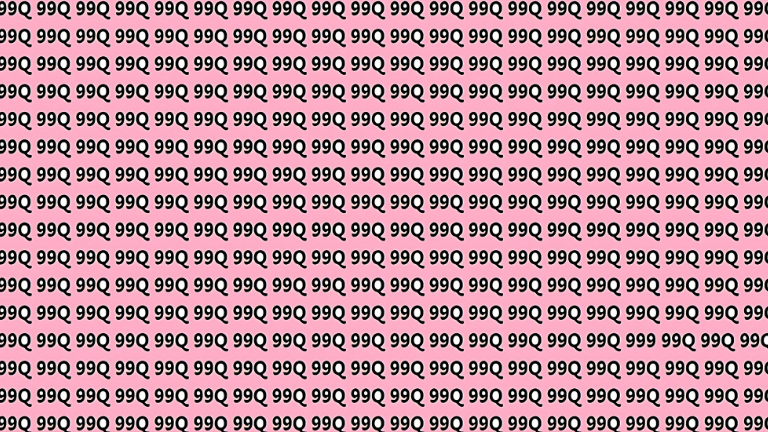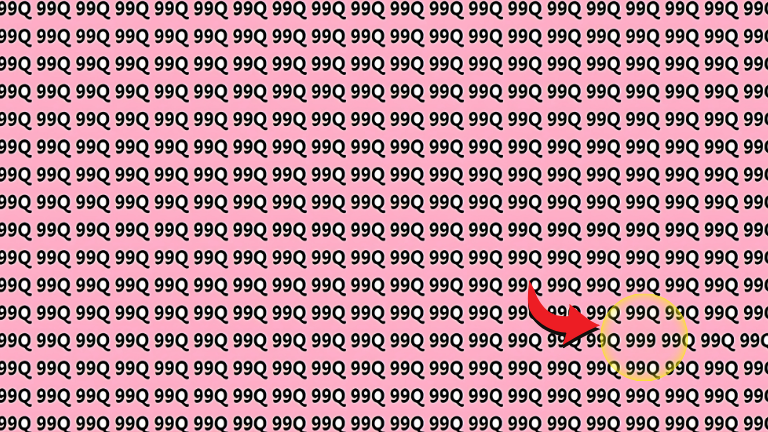Visual puzzles have fascinated humans for centuries. They challenge our perception and make us question what we see.
The latest viral sensation involves finding the number 999 hidden among countless 99Qs. This seemingly simple task proves more difficult than most people expect.
What Makes This Optical Illusion So Challenging?
Our brains process visual information in fascinating ways. When we look at repetitive patterns, our eyes often miss subtle differences.
The 99Q pattern creates a visual noise that camouflages the 999. Your brain automatically groups similar shapes together, making the hidden number nearly invisible.

The Science Behind Visual Perception
Pattern recognition is one of our brain’s most powerful abilities. However, this strength can become a weakness when solving visual puzzles.
Scientists call this phenomenon “visual masking.” The overwhelming presence of similar shapes makes it harder to spot the different element.
Why 10 Seconds Matters
Most people need at least 10 seconds to locate the hidden 999. This timeframe tests your quick visual processing skills.
Some individuals with exceptional visual acuity can spot it faster. Others might need several minutes of careful scanning.
Strategies for Solving Hidden Number Puzzles
Professional puzzle solvers use specific techniques to crack these challenges. Learning these methods can improve your success rate dramatically.
Systematic scanning involves moving your eyes in organized patterns across the image. This prevents you from missing sections or getting overwhelmed.
The Grid Method
Divide the puzzle into imaginary squares or rectangles. Examine each section thoroughly before moving to the next area.
This approach ensures complete coverage of the entire puzzle. It also helps maintain focus on smaller, manageable portions.
Peripheral Vision Technique
Sometimes the answer appears when you’re not looking directly at it. Use your peripheral vision to catch subtle differences.
Look slightly to the side of where you think the answer might be. This technique often reveals hidden elements that direct focus misses.
Color and Contrast Focus
Pay attention to slight variations in shading or thickness. The number 999 might appear slightly different from the surrounding 99Qs.
These minimal differences become more apparent when you specifically look for them. Train your eyes to notice these subtle variations.
Common Mistakes People Make
Many puzzle solvers make predictable errors that prevent them from finding the answer. Understanding these mistakes helps you avoid them.
Rushing is the biggest obstacle to success. When you feel pressured by time limits, your brain processes information less effectively.
Looking Too Hard
Ironically, trying too intensely can make the puzzle harder to solve. Relaxed observation often works better than concentrated staring.
Take brief breaks if you feel your eyes getting tired. Fresh perspective often reveals what intensive searching couldn’t find.
Assuming Specific Locations
Many people expect hidden elements to appear in obvious places like corners or centers. The 999 could be anywhere within the pattern.
Avoid focusing only on these predictable locations. The puzzle creators often place answers in unexpected spots.
The Psychology of Optical Illusions
These puzzles reveal interesting facts about human cognition and visual processing. They demonstrate how our brains take shortcuts to interpret information quickly.
Gestalt principles explain why we see patterns and groups rather than individual elements. This natural tendency both helps and hinders puzzle solving.
Individual Differences in Visual Processing
Not everyone processes visual information the same way. Some people naturally excel at spotting hidden elements.
Age, experience, and visual training all affect performance on these puzzles. Regular practice can significantly improve your skills.
The Role of Attention
Selective attention determines what we notice in complex visual scenes. This cognitive filter helps us focus but can also cause us to miss important details.
Training your attention to be more flexible improves puzzle-solving abilities. Meditation and mindfulness practices can enhance this skill.
Benefits of Solving Visual Puzzles
Regular engagement with optical illusions provides several cognitive benefits. These activities function as exercise for your brain.
Visual processing speed improves with practice. You’ll notice details more quickly in everyday situations.
Enhanced Problem-Solving Skills
These puzzles teach persistence and systematic thinking. The strategies you learn apply to many real-world challenges.
Pattern recognition abilities strengthen through regular practice. This skill proves valuable in numerous professional and personal contexts.
Stress Relief and Entertainment
Solving puzzles provides a healthy mental break from daily stress. The focused attention required creates a meditative state.
Achievement satisfaction comes from successfully completing challenging tasks. This positive feeling boosts mood and confidence.
Tips for Creating Your Own Hidden Number Puzzles
Understanding puzzle construction helps you become a better solver. Design principles reveal the creator’s intended challenges.
Choose contrasting elements that are similar enough to create confusion but different enough to be distinguishable. Balance is crucial for effective puzzles.
Difficulty Levels
Beginner puzzles use obvious differences in size or color. Advanced versions require detecting minimal variations in shape or orientation.
Consider your target audience when designing puzzle difficulty. Too easy becomes boring; too hard creates frustration.
Testing and Refinement
Have multiple people test your puzzles before sharing them widely. Feedback helps you understand what works and what doesn’t.
Time tracking reveals whether your puzzle meets intended difficulty levels. Adjust elements based on solver performance data.
Advanced Techniques for Expert Solvers
Experienced puzzle enthusiasts develop sophisticated approaches over time. These advanced methods separate novices from experts.
Speed scanning involves rapid eye movements across the entire image. This technique helps identify areas that “feel different” before detailed examination.
Multi-Focus Technique
Train yourself to maintain broad awareness while scanning for specific elements. This dual attention approach improves detection rates.
Practice exercises can develop this skill over time. Start with simple puzzles and gradually increase complexity.
Memory Pattern Training
Develop visual memory for common puzzle patterns and solutions. This background knowledge accelerates future solving.
Regular practice builds an internal database of visual patterns. Experienced solvers recognize familiar elements instantly.
Digital vs. Physical Puzzle Experiences
Screen-based puzzles offer different challenges than printed versions. Display quality, brightness, and screen size all affect difficulty.
Eye strain becomes a factor during extended digital puzzle sessions. Take regular breaks to maintain peak performance.
Optimal Viewing Conditions
Proper lighting and screen positioning significantly impact solving success. Avoid glare and maintain comfortable viewing distances.
Display settings like brightness and contrast can make hidden elements more or less visible. Experiment with these adjustments.
The Cultural Impact of Viral Puzzles
Social media has transformed how optical illusions spread and evolve. Viral challenges bring these puzzles to millions of people worldwide.
Community engagement forms around shared puzzle-solving experiences. People enjoy comparing times and sharing strategies.

Educational Applications
Teachers use these puzzles to demonstrate perception principles and cognitive biases. They provide engaging ways to explore psychological concepts.
Research applications help scientists study visual processing and attention mechanisms. Puzzle performance data reveals insights about human cognition.
Frequently Asked Questions
Q: How long should I spend looking for the hidden 999? Give yourself at least 10 seconds of focused searching before looking for hints or answers.
Q: Is there a trick to finding hidden numbers quickly? Systematic scanning and relaxed observation work better than intense staring or rushing.
Q: Why do some people find these puzzles easier than others? Individual differences in visual processing, attention skills, and practice levels affect performance.
Q: Can regular puzzle solving improve my vision? While puzzles don’t improve eyesight, they can enhance visual processing speed and pattern recognition.
Q: Are there age limits for these types of puzzles? People of all ages can enjoy optical illusions, though visual acuity naturally changes over time.
Q: What makes the 999 hidden among 99Qs particularly challenging? The similar shapes create visual masking, making the different element harder to distinguish.
Q: Should I use any specific eye movements while searching? Try systematic grid scanning or peripheral vision techniques rather than random looking.
Q: How often should I practice with optical illusions? Regular practice, even just a few minutes daily, can significantly improve your skills over time.